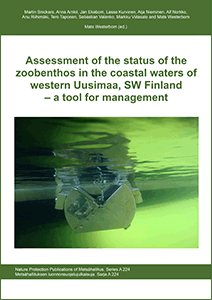Assessment of the status of the zoobenthos in the coastal waters of western Uusimaa, SW Finland – a tool for management
Marine Strategy Framework Directive (MSFD) targets a Good Environmental Status (GES) by 2020 for all the marine waters of all EU Member States. According to the Water Framework Directive (WFD), all EU member states should protect, enhance and restore all bodies of surface water in an aim to achieve a Good Ecological Status. The marine strategies to be developed by each Member State includes a detailed assessment of the state of the environment, a definition of GES at regional level and established targets based on indicators as well as monitoring. The structure of zoobenthos is one indicator that is being monitored. This study aimed at 1) elucidating the benthic condition of coastal waters in the western Uusimaa using zoobenthos as indicators, 2) evaluate the representativeness of the ongoing benthic monitoring programme and 3) compare hydrological monitoring data with proximate benthic data. To evaluate the representativeness of the ongoing monitoring, we used data from 36 official monitoring stations that were compared with an extended survey including > 440 samples.
The extended survey showed that there was a clear effect of sediment quality (normal or signs of oxygen shortage) on zoobenthos, generally, and Macoma balthica population structure, specifically, with a much more heterogeneous population structure in healthy sediments. Most of the zoobenthos indices were higher in the deep outer archipelago than in the deep inner archipelago, suggesting a better benthic status in the outer areas. Zoobenthos metrics were usually more similar in affected sediments, which indicate that decreased sediment quality makes the naturally occurring spatial and vertical gradients less marked and the benthic community less heterogeneous in a landscape perspective. The overall status of shallow coastal areas differed between the two data-sets. The extended survey resulting in overall higher ecological status of the Uusimaa coastal waters than results indicated by the monitoring data. The spatial linkage between water quality monitoring stations and zoobenthos indices was stronger at the extended survey sites. The extended survey sites near higher-oxygen stations had higher mean total abundance, species richness and diversity than the sites near low-oxygen stations. In addition, the water quality stations near extended survey sites with signs of oxygen shortage had clearly lower oxygen concentration than stations near sites with normal sediment quality.
The results of the study suggest that the current monitoring programme (using only zoobenthos as indicator) doesn’t fully reflect the zoobenthic conditions in the entire western Uusimaa. The extended survey also indicated that midst among larger areas of poor condition, locally there may be areas that are in good or very good condition. The results of the study therefore suggest that the benthic monitoring programme in Uusimaa should be revised including a more diverse set of stations. For management and conservation, results pinpoint the need for fine scale surveys when assessing the state of any area in e.g. environmental impact assessments.

Julkaisussa (Länsi-Uudenmaan saariston merenpohjan tila: pohjaeläinyhteisöt tilan ilmentäjinä ja hallinnon työkaluna) on tiivistelmän lisäksi laajempi suomenkielinen yhteenveto.